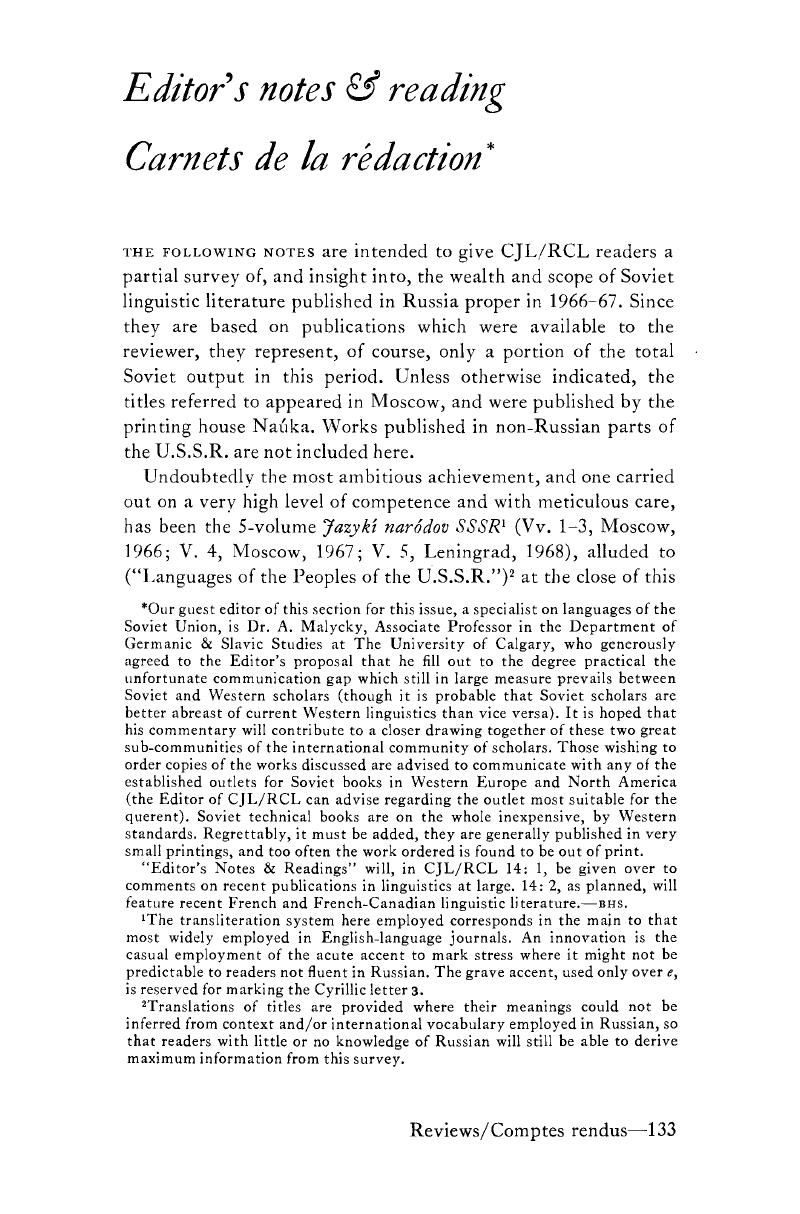No CrossRef data available.
Article contents
Editor’s notes & reading/Carnets de la rédaction*
Published online by Cambridge University Press: 27 June 2016
Abstract

- Type
- Editorial
- Information
- Canadian Journal of Linguistics/Revue canadienne de linguistique , Volume 13 , Issue 2 , Spring 1968 , pp. 133 - 141
- Copyright
- Copyright © Canadian Linguistic Association 1968
Footnotes
Our guest editor of this section for this issue, a specialist on languages of the Soviet Union, is Dr. A. Malycky, Associate Professor in the Department of Germanic & Slavic Studies at The University of Calgary, who generously agreed to the Editor’s proposal that he fill out to the degree practical the unfortunate communication gap which still in large measure prevails between Soviet and Western scholars (though it is probable that Soviet scholars are better abreast of current Western linguistics than vice versa). It is hoped that his commentary will contribute to a closer drawing together of these two great sub-communities of the international community of scholars. Those wishing to order copies of the works discussed are advised to communicate with any of the established outlets for Soviet books in Western Europe and North America (the Editor of CJL/RCL can advise regarding the outlet most suitable for the querent). Soviet technical books are on the whole inexpensive, by Western standards. Regrettably, it must be added, they are generally published in very small printings, and too often the work ordered is found to be out of print.
“Editor’s Notes & Readings” will, in CJL/RCL 14: 1, be given over to comments on recent publications in linguistics at large. 14: 2, as planned, will feature recent French and French-Canadian linguistic literature.—BHS.
References
1 The transliteration system here employed corresponds in the main to that most widely employed in English-language journals. An innovation is the casual employment of the acute accent to mark stress where it might not be predictable to readers not fluent in Russian. The grave accent, used only over e, is reserved for marking the Cyrillic letter 3.
2 Translations of titles are provided where their meanings could not be inferred from context and/or international vocabulary employed in Russian, so that readers with little or no knowledge of Russian will still be able to derive maximum information from this survey.
3 The different principle of organizing an utterance on the nominative model— typical, for instance, for certain stages of all Indo-European or Finno-Ugric languages—and on the ergative model, is best exhibited in the ability of the verb form to show agreement. In the nominative model, the transitive verb form agrees with the grammatical subject of the utterance only, regardless of the perspective from which the activity is viewed: that of the agent, in the active voice; or that of the recipient of the activity of the agent, in the passive voice. In the ergative model the transitive verb form shows agreement with the agent and the recipient of the activity of the agent simultaneously, both the perspective of the recipient of the activity, conceived as the subject of the state resulting from the activity of the agent, and the perspective of the logical subject, i.e., the agent, being shown at the same time. As a result of this it lacks the category of the direct object and, with it, that of the accusative case, as well as the ability to distinguish active and passive voices. Intransitive verbs are conceived in the ergative model languages as activity verbs and agree only with the agent. On the other hand, while in the nominative model languages the agreement of the transitive verb form with the grammatical subject does not differ from that in the intransitive verb forms, in the ergative model languages the transitive and intransitive verbs are formally distinguished: transitive verbs show their double agreement in the conjugational pattern which has the subject-object markers, intransitive ones appear with subject markers only. In the ergative model languages the agent of the intransitive verbs takes the absolute case which corresponds to the nominative case of the nominative model languages; when a transitive verb is used, the direct object appears in the absolute case, while the agent takes the ergative case.
4 Specifically, the Ukrainian Cyrillic alphabet, augmented by one purely Russian and four Latin script letters.


